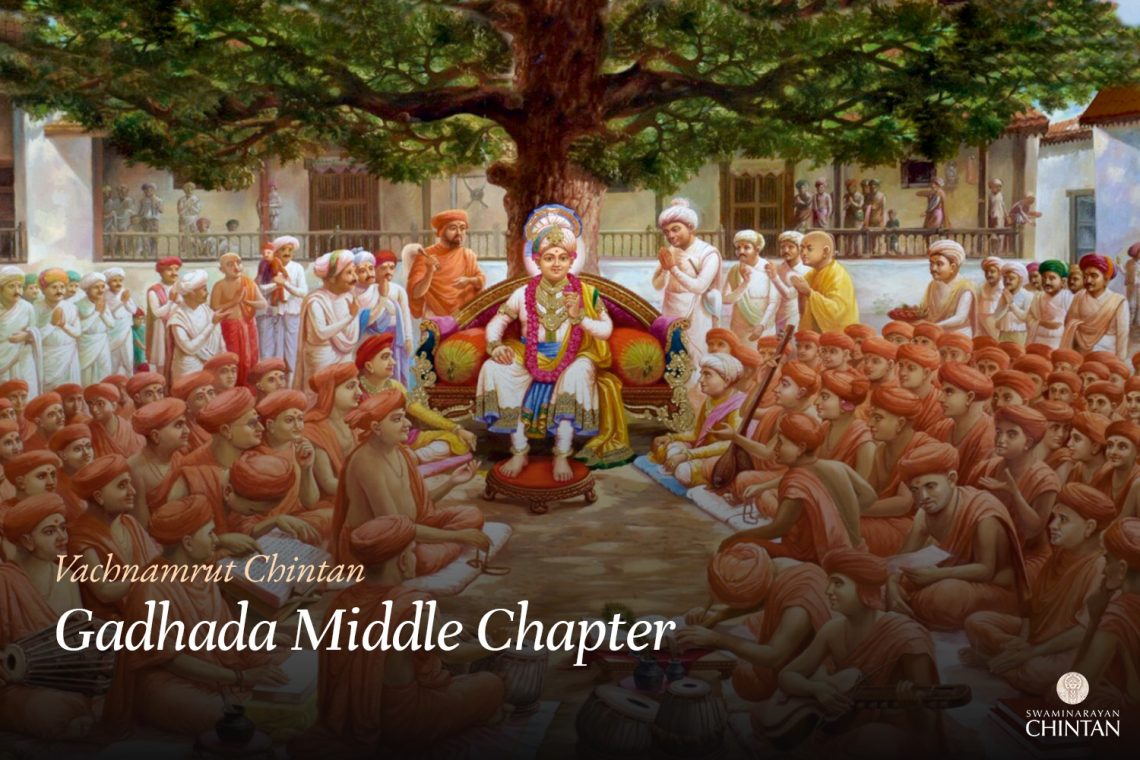Central Insights:
- The characteristics of one whose mind is firmly attached to the form of Bhagwan.
Key Points:
- Attachment to Bhagwan surpasses attachment to the body and the material world.
- Firm attachment to Bhagwan can be developed through the service of an ekantik (single-minded) Sadhu.
Explanation:
This Vachanamrut is about intense attachment to Bhagwan. Maharaj explains that a devotee whose mind is firmly attached to the murti of Bhagwan exhibits the following traits: Even if they are extremely exhausted from a long journey, so tired that they lack the energy to sit properly, or if they are suffering from illness or have been insulted, or if they have been overtaken by the affluence of a great kingdom, the moment an opportunity arises to hear the talks of Bhagwan, they become attentive and eager as if none of these difficulties exist. This eagerness demonstrates their firm attachment to Bhagwan.
Maharaj here equates talks about Bhagwan with His form. In truth, the murti of Bhagwan is His form, but since His talks reveal His form and greatness, the talks are considered a significant aspect of His form. Thus, Maharaj regards talks about Bhagwan as His form.
Now, the question arises, how can one measure attachment to Bhagwan? Is it based on how much time a devotee spends listening to talks of Bhagwan? One thing is certain: a person spends more time on what they are truly attached to, and less on other things.
There may be a devotee who listens to talks of Bhagwan all day, or delivers such talks. Another devotee may not spend as much time on these talks, but engages in other activities—such as service—that please Bhagwan, allocating a limited time to the talks. Based on this Vachanamrut, whose attachment to the form of Bhagwan would be considered stronger?
If we say it’s the one who spends more time in talks, a conflict arises, because our nand santo like Muktanand Swami, Gopalanand Swami, Brahmanand Swami, and others may not have been able to spend as much time in talks as current devotees do, due to the conditions of their time. We can imagine how much more difficult it was in their circumstances than today. But we can’t say that they were any less devoted than the current devotees. No sincere heart would accept that. So what exactly is Maharaj emphasizing here?
Through this Vachanamrut, Maharaj wants to convey that when exhaustion, intense urge, pain, humiliation, or wealth become distractions, these are forms of attachment to the body or the world. In contrast, attachment to Bhagwan is nurtured by talks of Bhagwan. When these two opposing forces collide, it becomes clear which attachment is stronger based on which one prevails.
If we simply say that we have affection for Bhagwan and also listen to talks when it’s convenient, that doesn’t signify extreme attachment. Listening to talks itself is not insignificant, but to understand extreme attachment, deeper contemplation is required. Only when one overcomes attachment to the body and the material world can one truly be said to have intense attachment to Bhagwan. Otherwise, what we do in ordinary times is mere time-passing, though it’s not wrong and can also nurture attachment if done with genuine devotion.
Being exhausted to the point of not being able to sit is a sign of attachment to the body. Overcoming this requires greater attachment to Bhagwan. Without this, there will be no enthusiasm.
When physical or mental ailments are distressing, or when humiliation disturbs the mind, or when one is immersed in worldly success or power, these are all forms of attachment to the material world. Only when one forsakes these attachments in favor of attachment to Bhagwan can one be said to have intense attachment to Him.
Many may claim to have intense attachment without having faced such obstacles, but that’s not true attachment. It is only proven under extreme circumstances.
Attachment comes with a certain intensity, creating a force that can overcome major obstacles and lead one to the goal, even if the devotee seems weak. The examples of gopis, Meerabai, Zamkuba, Prahlad, Dhruv, and others, like Mulji-Krishnaji from Kutch and Hemraj Shah, illustrate that it wasn’t their physical strength but their intense attachment to Bhagwan that led them to their goal.
Then, Muktanand Swami asked, “How can one develop such firm attachment to Bhagwan?” To this, Maharaj replied, “Either through the powerful influence of one’s past sanskar (karmic impressions) or by serving a Sadhu who has such attachment, thereby earning his blessings.”
The unwavering love described in this Vachanamrut can be attained in two ways: either through the influence of past sanskar, or by serving a Sadhu who has intense attachment to Bhagwan and gaining his blessings. These blessings give the devotee the strength to overcome obstacles and develop intense attachment to Maharaj. These are the only two ways to attain it.
Glossary
| Bhagwan – God |
| Murti – Divine form of God Refers to Bhagwan’s physical or imagined divine form, which provides joy and spiritual connection during contemplation. |
| Sanskar – Karmic impressions Deep-rooted tendencies from past lives that influence one’s spiritual inclinations and attachments. |
| Attachment – Clinging to sensory pleasures A tendency of the mind to become absorbed in pleasant objects, diverting the jiva from spiritual welfare. |
| Gopis – Devotees of Krishna The cowherd women of Vrindavan known for their unparalleled love for Krishna. |
| Vartman – Sacred vows Spiritual rules and disciplines undertaken by devotees to remain on the path of righteousness. |

